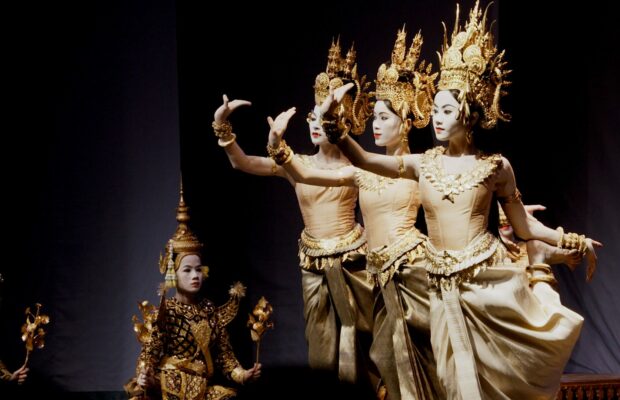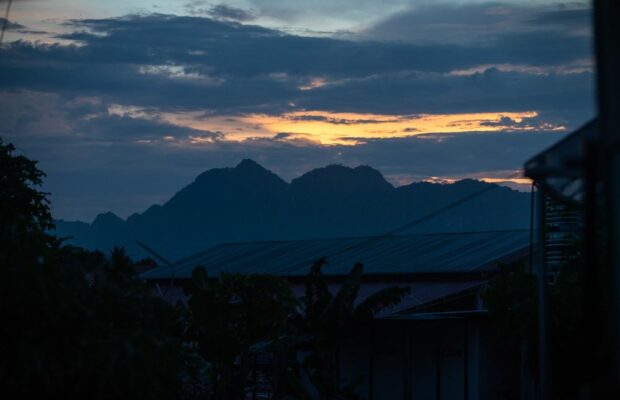The perfect motion: the Royal Cambodian Ballet
Kept within the confines of the royal palace, classical Cambodian dance was for centuries a sacred and secret art, reserved for the king and […]
Kept within the confines of the royal palace, classical Cambodian dance was for centuries a sacred and secret art, reserved for the king and his court. In 1906, a historic visit to France revealed this age-old artistic performance to the general public. Amidst the audience at the Royal Khmer Ballet, the sculptor Rodin was mesmerised. A modern masterpiece brought to life in an exceptional documentary: The perfect motion, about to be released in cinemas.
Text : Antoine BESSON – Photos : ALOEST – THE PERFECT MOTION

Dance is such a sacred art in Cambodia that for over a thousand years now, it is said to have enabled men to converse with the gods. Or should we say women, given that until the twentieth century, classical Cambodian dance was an exclusively female art form. It was an ancient form of “dance theatre”, intimately linked to the royal household. Dancers, with their faces covered in white to conceal any human emotion, dressed in the finest costumes and the most precious fabrics, sewn with gold thread, seem to transcend themselves during the performances of the royal ballet.
With this incantatory dance, they embody a link between the divinities and mankind, manifested in a strange, slow but rhythmic choreography. Their movements seem almost disjointed and unearthly, yet they speak a language to those who know how to decipher it.
Discovering the art of classical Cambodian dance means learning its secrets. It is both a historical and cultural voyage into the mysteries of this divine art, whose origins date back thousands of years.
” In modern Cambodia, there are two symbols with which all Khmers identify and which serve as markers of their identity: the temples of Angkor and the figure of the Apsara “, explains the film director, who was privileged to work with renowned masters to understand the art he was filming, including Princess Norodom Buppha Devi.
The eldest daughter of King Sihanouk and half-sister of Sihamoni, the current King of Cambodia, trained in the art of classical Cambodian dance from the age of 6. She was a former prima ballerina and headed the Royal Ballet until she passed away November 18, 2019. In this documentary, the woman who created the Apsara dance delivers a very moving artistic testament, as the filmmaker follows her during her latest creation for the Paris Philharmonic: Métamorphoses.

This thousand-year-old art does not necessarily mean it has not evolved over time. The whole point of the film was to show, both the ancient origins of this art form and its modern transformation. Ballet is by no means immutable, and the 20th century was a golden age for a genre that is now part of UNESCO’s World Oral and Intangible Heritage List. Under the impetus of Queen Sisowath Kossamak, grandmother to Princess Buppha Devi and to the current king, the royal ballet emerged from the private confines of the palace, shifting its focus from the divinities to mankind, and becoming in the process a highly fashionable tool of Cambodian soft power.
This spectacular production required months of preparation. Xavier de Lausanne’s camera reveals the intimate secrets of rehearsals, giving us an opportunity to understand and admire the symbolism and technicality of the dancers’ movements. More importantly, it tells the story of a genuine fascination: that felt by the sculptor Auguste Rodin when he discovered the dancers of the Royal Cambodian Ballet at the Pré Catelan in 1906, during their very first performance outside the royal palace in Phnom Penh. This encounter resulted in dozens of sketches, reproduced on screen in a stunningly beautiful display. Contemporary dancers choreograph to perfection the poise immortalised by the sculptor, thereby testifying to the remarkable longevity of this dance from ancient times.
The Royal Ballet company tours the world. Everyone is fascinated by the dancers’ almost surreal, ethereal movements.
This, is undoubtedly one of the most fascinating aspects of these choreographies: the astonishing flexibility of the dancers, who manage to force their limbs into movements that seem anatomically unnatural. A flexibility that Xavier de Lauzanne claims is natural to the Cambodian

“Dance is part of Cambodian people’s DNA. They all possess this natural flexibility and it is the language through which they celebrate the important moments in their lives. – Xavier de Lauzanne “

However, while all Cambodians dance, not everyone knows the history of this dance. The Khmer Rouge dictatorship is to blame for this. Ruled by an ideology that glorified an agricultural and working-class nation, the country lost an extremely important part of its intellectual, cultural and artistic elite. Accounts show to what extent this art form narrowly escaped oblivion.
The dance’s ethereal delicacy has nevertheless survived, and this is the story that Xavier de Lauzanne tells us. ” This chapter in the history of the Royal Ballet bears a universal significance. It is fascinating to explore the link that exists between art and the identity, resilience and reconstruction of a nation.”
It is as though classical dance had broken out of the royal palace in the 20th century at the very moment when the Cambodian people needed it most, helping to restore their pride and courage after the horrors of war. As a result, The perfect motion became a statement in honour of culture and beauty. The immediate success of the film’s national release in Cambodia reflected the quest of young Khmer people for identity: “The arts
are one of the major elements that make up national identity, and the recent history of the Khmer people shows how essential culture is to the process of rebuilding a country after a war. But beyond this specific context, this film is also an apology for universal beauty”, adds the director. This beauty shines through all 86 minutes of the film, both in the images and in the delicate narration of the Royal Ballet’s epic story. It is firmly rooted in Xavier de Lauzanne’s belief: “In today’s world, blighted by violence and war, we must embrace beauty!”

Kept within the confines of the royal palace, classical Cambodian dance was for centuries a sacred and secret art, reserved for the king and […]

Marine is sponsoring Janyawan (Hom), a little boy from Thailand. During her trip to Thailand, she visited him at his school…

Southeast Asia’s captivating diversity and natural beauty are juxtaposed with entrenched socio-economic challenges. Poverty, high infant mortality, and limited access to education plague the […]

The village of Huay Duea in Laos is located 70 kilometres north of Vientiane.